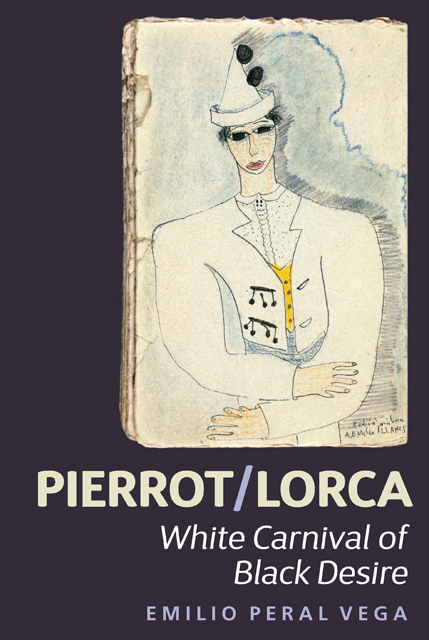Book contents
- Frontmatter
- Dedication
- Contents
- List of Illustrations
- Acknowledgements
- Prologue
- 1 A Modern Mask: From Deburau to The Tramp
- 2 First Examples of an Effeminate Pierrot: From Verlaine to Lorca
- 3 Pierrot/Lorca: Alter Ego for a Young Poet
- 4 Lorca/Pierrot: Between Painting and Theatre
- 5 Love Game and Masquerade: Dalí/Lorca
- 6 Perlimplín/Lorca/Pierrot: Frustrated Desire
- 7 A White Clown for a Black Desire: El público and Así que pasen cinco años
- Epilogue
- Bibliography
- Index
4 - Lorca/Pierrot: Between Painting and Theatre
Published online by Cambridge University Press: 22 February 2023
- Frontmatter
- Dedication
- Contents
- List of Illustrations
- Acknowledgements
- Prologue
- 1 A Modern Mask: From Deburau to The Tramp
- 2 First Examples of an Effeminate Pierrot: From Verlaine to Lorca
- 3 Pierrot/Lorca: Alter Ego for a Young Poet
- 4 Lorca/Pierrot: Between Painting and Theatre
- 5 Love Game and Masquerade: Dalí/Lorca
- 6 Perlimplín/Lorca/Pierrot: Frustrated Desire
- 7 A White Clown for a Black Desire: El público and Así que pasen cinco años
- Epilogue
- Bibliography
- Index
Summary
In order to understand Federico García Lorca’s visual depiction of Pierrot, the influence of two unique individuals is critical: the Uruguayan Rafael Barradas and the Frenchman Jean Cocteau. Lorca came into contact with the former after attending a lecture that he delivered at the Ateneo in Madrid in April 1921, as part of an Ultraist movement event advertised under the banner of ‘El anti-yo, estudio teórico sobre el clownismo y dibujos en la pizarra’. We have no evidence that the lecture was transcribed, but some details have come down to us indirectly such as ‘Kaleidoscopio. Nuestra segunda velada’, a report published in issue 10 of the journal Ultra (May 1921):
Anunciada por los carteles de Jahl que se exhibieron en la Carrera de San Jerónimo, nuestra segunda Velada se celebró el sábado 30 del pasado abril. El Ateneo nos abrió sus puertas deseoso de oír nuestra palabra, nueva y vibrante. La Sección de Literatura quiso que fuésemos a leer nuestros poemas en la tradicional cátedra ateneísta, y nosotros fuimos a ella con la libertad y el entusiasmo, que son dos de nuestras virtudes. Se leyeron cuartillas sobre estética ultraísta, se pronunciaron palabras bautismales y se recitaron poemas, siguiendo este orden; 1.º ‘Ultraísmo: alegría de ser poeta’ y ‘Caminos de hierro’ (poema que publicamos en este mismo número), por Rafael Lasso de la Vega. 2.° ‘Consideraciones estéticas’ y ‘Puzzle’, poemas por Guillermo de Torre. 3.º ‘Palabras’ de Antonio Martínez Cubero. 4.º ‘Exaltación de la rana ultraica’ y ‘Poema’, por López-Parra. 5.° ‘Ki-ki-ri-ki’ (que publicamos en este número) y otros dos poemas, por Humberto Rivas. 6.º ‘Poemas’, por José Rivas Panedas. 7.° ‘El poema de las manos’, por Pérez Doménech. 8.° ‘El anti-yo’ estudio teórico sobre el clownismo, y dibujos en la pizarra, por Barradas. 9.º ‘Especímenes’, por César Álvarez Comet. 10.° Poemas de Ciria y Escalante. 11.° ‘Poemas’, por Luque y Eliodoro Puche. 12.° ‘Fuegos artificiales’, poema humorístico de Vighi, con quien simpatizamos cordialmente, aunque no figura dentro del movimiento ultraísta.
La Velada fue un éxito clamoroso para nosotros, a pesar de las protestas de una exigua minoría retardataria y obtusa, que originó la indignación del público en general al grito de ‘idiotas los que protestan’, lanzado valientemente por Andrés González-Blanco, fogoso defensor del arte nuevo.
- Type
- Chapter
- Information
- Pierrot/LorcaWhite Carnival of Black Desire, pp. 61 - 76Publisher: Boydell & BrewerPrint publication year: 2015

